Matrices
4.4. Special Matrices.
1. A square matrix is a matrix with the same number of rows as columns.
2. A diagonal matrix is a square matrix whose entries off the main
diagonal are
zero.
3. An upper triangular matrix is a matrix having all the entries below
the main
diagonal equal to zero.
4. A lower triangular matrix is a matrix having the entries above the
main diagonal
equal to zero.
5. The n × n identity matrix, I, is the n × n matrix with ones down the
diagonal
and zeros elsewhere .
6. The inverse of a square matrix, A, is the matrix A-1, if it exists,
such that
AA-1 = A-1A = I.
7. The transpose of a matrix
![]() is
is
 .
.
8. A symmetric matrix is one that is equal to its transpose.
Discussion
Many matrices have special forms and special properties . Notice that, although
a diagonal matrix must be square, no such condition is put on upper and lower
triangular matrices.
The following matrix is a diagonal matrix (it is also upper and lower
triangular ).
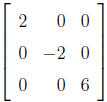
The following matrix is upper triangular.
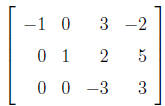
The next matrix is the transpose of the previous matrix .
Notice that it is lower
triangular.
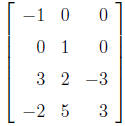
The identity matrix is a special matrix that is the
multiplicative identity for any
matrix multiplication. Another way to define the identity matrix is the square
matrix
 where
where  if i
≠ j and
if i
≠ j and  . The n × n identity I has the
property
. The n × n identity I has the
property
that IA = A and AI = A, whenever either is defined. For example,

The inverse of a matrix A is a special matrix A-1 such
that AA-1 = A-1A = I. A
matrix must be square to define the inverse. Moreover, the inverse of a matrix
does
not always exist.
Example 4.4.1.

so that

The transpose of a matrix is the matrix obtained by
interchanging the rows for
the columns. For example, the transpose of

If the transpose is the same as the original matrix, then
the matrix is called
symmetric. Notice a matrix must be square in order to be symmetric .
We will show here that matrix multiplication is distributive over matrix
addition.
Let
![]() and
and
![]() be m × n matrices and
let
be m × n matrices and
let ![]() be an n × p
be an n × p
matrix. We use the definitions of addition and matrix multiplication and the
distributive
properties of the real numbers to show the distributive property of matrix
multiplication. Let i and j be integers with 1≤ i ≤ m and 1 ≤ j ≤ p. Then the
element in the i-th row and the j-th column in (A + B)C would be given by
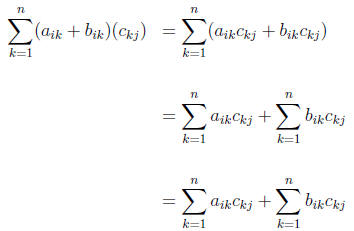
This last part corresponds to the form the element in the
i-th row and j-th column
of AC + BC. Thus the element in the i-th row and j-th column of (A + B)C is the
same as the corresponding element of AC + BC. Since i and j were arbitrary this
shows (A + B)C = AC + BC.
The proof that C(A+B) = CA+CB is similar. Notice that we must be careful,
though, of the order of the multiplication. Matrix multiplication is not
commutative.
4.5. Boolean Arithmetic . If a and b are binary digits (0 or 1), then
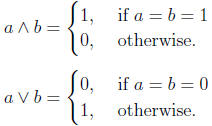
Definitions 4.5.1. Let A and B be n × m matrices.
1. The meet of A and B: 
2. The join of A and B: 
Definition 4.5.1. Let ![]() be
m × k and
be
m × k and ![]() be k × n. The
Boolean
be k × n. The
Boolean
product of A and B,  , is the m × n matrix
, is the m × n matrix
![]() defined by
defined by

Discussion
Boolean operations on zero -one matrices is completely analogous to the standard
operations, except we use the Boolean operators
 and
and  on the binary digits
instead
on the binary digits
instead
of ordinary multiplication and addition , respectively.
4.6. Example 4.6.1.
Example 4.6.1. Let

Then
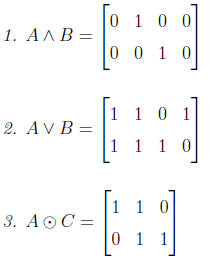
Here are more details of the Boolean product in Example 4.6.1:

Exercise 4.6.1.

Find

Exercise 4.6.2.
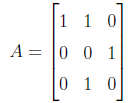
Find

Exercise 4.6.3.
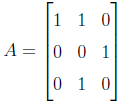
Find  , the Boolean
product of A with itself n times . Hint: Do exercise 4.6.2
, the Boolean
product of A with itself n times . Hint: Do exercise 4.6.2
first.
| Prev | Next |